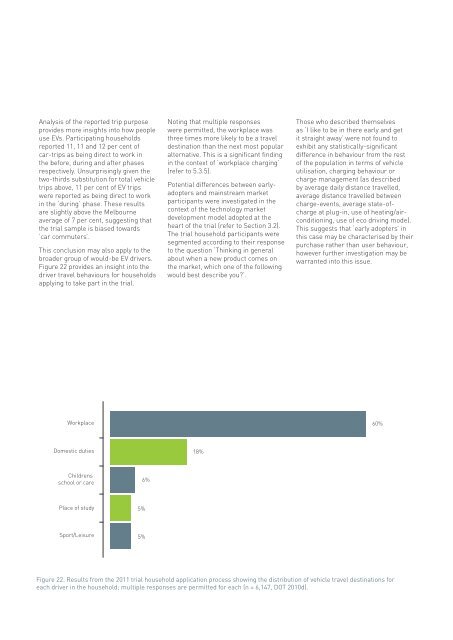victorian electric vehicle trial mid-term report - Department of Transport
victorian electric vehicle trial mid-term report - Department of Transport
victorian electric vehicle trial mid-term report - Department of Transport
- No tags were found...
Create successful ePaper yourself
Turn your PDF publications into a flip-book with our unique Google optimized e-Paper software.
Analysis <strong>of</strong> the <strong>report</strong>ed trip purposeprovides more insights into how peopleuse EVs. Participating households<strong>report</strong>ed 11, 11 and 12 per cent <strong>of</strong>car-trips as being direct to work inthe before, during and after phasesrespectively. Unsurprisingly given thetwo-thirds substitution for total <strong>vehicle</strong>trips above, 11 per cent <strong>of</strong> EV tripswere <strong>report</strong>ed as being direct to workin the ‘during’ phase. These resultsare slightly above the Melbourneaverage <strong>of</strong> 7 per cent, suggesting thatthe <strong>trial</strong> sample is biased towards‘car commuters’.This conclusion may also apply to thebroader group <strong>of</strong> would-be EV drivers.Figure 22 provides an insight into thedriver travel behaviours for householdsapplying to take part in the <strong>trial</strong>.Noting that multiple responseswere permitted, the workplace wasthree times more likely to be a traveldestination than the next most popularalternative. This is a significant findingin the context <strong>of</strong> ‘workplace charging’(refer to 5.3.5).Potential differences between earlyadoptersand mainstream marketparticipants were investigated in thecontext <strong>of</strong> the technology marketdevelopment model adopted at theheart <strong>of</strong> the <strong>trial</strong> (refer to Section 3.2).The <strong>trial</strong> household participants weresegmented according to their responseto the question ‘Thinking in generalabout when a new product comes onthe market, which one <strong>of</strong> the followingwould best describe you?’.Those who described themselvesas ‘I like to be in there early and getit straight away’ were not found toexhibit any statistically-significantdifference in behaviour from the rest<strong>of</strong> the population in <strong>term</strong>s <strong>of</strong> <strong>vehicle</strong>utilisation, charging behaviour orcharge management (as describedby average daily distance travelled,average distance travelled betweencharge-events, average state-<strong>of</strong>chargeat plug-in, use <strong>of</strong> heating/airconditioning,use <strong>of</strong> eco driving mode).This suggests that ‘early adopters’ inthis case may be characterised by theirpurchase rather than user behaviour,however further investigation may bewarranted into this issue.Workplace 60%Domestic duties18%Childrensschool or care6%Place <strong>of</strong> study5%Sport/Leisure 5%Figure 22. Results from the 2011 <strong>trial</strong> household application process showing the distribution <strong>of</strong> <strong>vehicle</strong> travel destinations foreach driver in the household; multiple responses are permitted for each (n = 6,147, DOT 2010d).
















